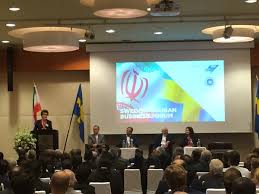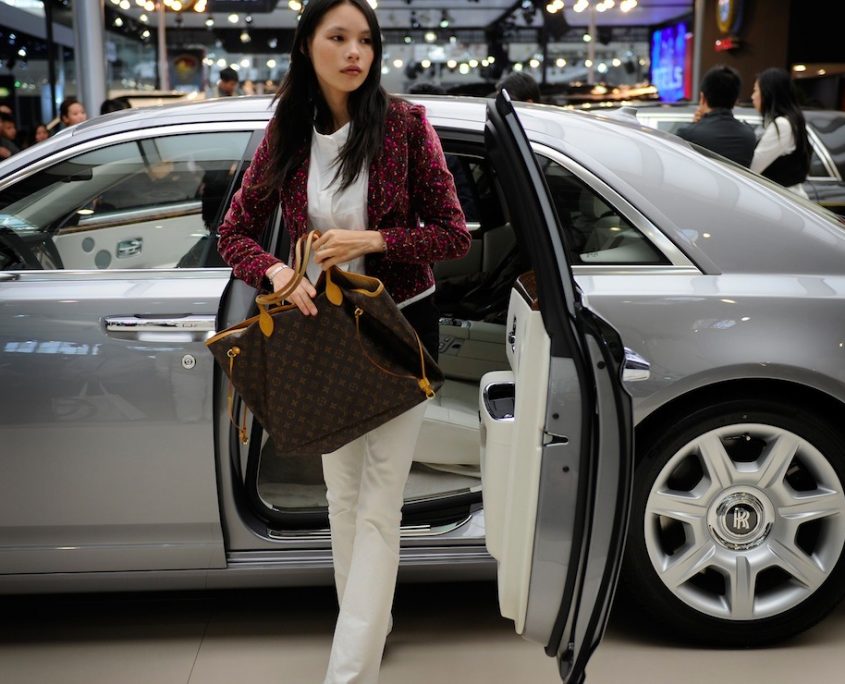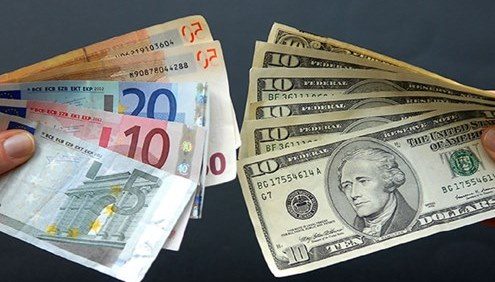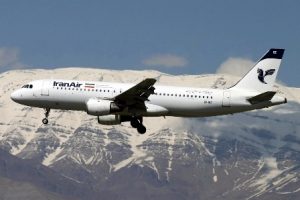Travelling with a 60-strong delegation of Iranian businessmen, Zarif also attended an Iran-Sweden mercantile conference in Stockholm.
Source : Tasnim News Agency
Annually Iran hosts many extensive exhibitions, events and fairs. Iran MICE Services has continuous and constant activity at these events. read about latest exhibitions, events, fairs news here. you can access to all information you need about all Iran exhibitions in the right time to stay updated!
Iran Telecom Innovations opened the 17th International Trade Show on Innovative CIT Solutions on September 25, 2016, in the presence of Iran’s minister of ICT and his deputies at Tehran International Fairgrounds. 225 exhibitors (+32%) from 23 countries are participating and the organisers expect more than 40,000 professional visitors to attend this major gathering of the Iranian ICT business community. Iran MICE Services is honored for providing hotel, visa, transportation, and other travel enquiries for the VIP guests of this conference.
Iran Doostan MICE Services will attend the World Travel Market 2016 to represent the best traveling packages and services to Iran and provide customers with quality contacts.
We look forward to discussing business opportunities, meet industry professionals, create a network with exhibitors, and sign contracts for organizing MICE (Meetings, Incentives, Conferences, Exhibitions) in Iran, and all the enquiries for business travelers including Hotel, Visa, Transfer, VIP services, etc.
It’s our great pleasure to meet you in our stand at ME 160, MIDDLE EAST HALL, London, on 7-9 November 2016.
Now in its second year, WHTS16 brings together the global family friendly tourism community in a unique summit dedicated to the needs of family friendly travel. Unlike other events in the Halal travel sector that only describe the issue, WHTS16 de nes and drives future initiatives and industry content. The summit presents insight and solutions and brings together tourism leaders, innovators, investors and stakeholders who all share one common aim of understanding and driving the family friendly travel industry.
The Halal Travel Industry’s Biggest Hosted Buyer Programme

Family friendly tourism is one of the fastest growing areas of global tourism and excluding Hajj and Umrah is set to surpass +US$ 238 billion by 2019.
The sector is tailored around the travel needs of Muslim tourists who predominately seek a family friendly environment.
Primary source markets include OIC member countries supported by non-Muslim majority markets with fast growing residents Muslim populations including Europe, North America, China and India.
Halal tourists are proven to travel with more family members, stay for a longer period and ultimately spend more money than any other tourism niche. For these reasons tourism brands across the globe are adapting their services to meet the needs of these guests.

Read More at : International Travel Week Abu Dhabi
Swedish Embassy in Tehran opens a trade office as part of its efforts to boost business ties between the European country and Iran.
In a meeting with head of Tehran’s Chamber of Commerce, Swedish Ambassador Peter Tiller said the newly-established bureau is run jointly by the Swedish government and private sector.
Tehran and Stockholm eye rise in their economic relations after implementation of the Joint Comprehensive Plan of Action (JCPOA), a lasting nuclear deal between Iran and the Group 5+1.
Since June, Iranian Foreign Minister Mohammad Javad Zarif paid a visit to Sweden as part of a European tour, and arranged meetings with senior Swedish officials, within Prime Minister Stefan Lofven. In a meeting with the Scandinavian nations’ Minister for Enterprise and Innovation Mikael Damberg during the journey, Zarif considered ways to strengthen economic interaction in the post-sanctions era.
Travelling with a 60-strong delegation of Iranian businessmen, Zarif also attended an Iran-Sweden mercantile conference in Stockholm.
Source : Tasnim News Agency

According to a new World Wealth Report from Capgemini, Asian millionaires now control more wealth than their peers in Europe, North America and other regions. Of the 5.1 million Asian millionaires in 2015, 2.7 million came from Japan and 1 million were from China. China had the fastest growth last year, hitting 16.2 percent, and is expected to expand even further in coming years.
Asian millionaires saw their wealth jump by 9.9 percent in 2015, while poor performance in the equity markets in the United States and Canada slowed growth in North America to 2.3 percent last year, and Europe’s growth was steady, with a 4.8 percent increase led by Spain and the Netherlands, According to CNN.
Latin American millionaires, meanwhile, suffered a decline in net worth of 3.7 percent, driven by political volatility and a turbulent stock market in Brazil. Europe’s growth was steady, with a 4.8 percent increase led by Spain and the Netherlands.
Asians’ net worth has soared over the past several years. The total wealth of Asia’s richest residents totaled $17.4 trillion in 2015, up from $8.4 trillion in 2006. North America’s wealthy have $16.6 trillion socked away, up from $11.2 trillion in 2006.
Asia also surpassed North America in terms of the number of millionaires in 2014. And their ranks grew even more last year, soaring 9.4 percent.
Of the 5.1 million Asian millionaires in 2015, 2.7 million came from Japan and one million were from China. There were 4.5 million US millionaires.
China had the fastest growth last year, hitting 16.2 percent, and is expected to expand even further in coming years.
Wealth in Asia is driven mainly by the financial services, high tech and healthcare industries. And it’s coming more from those owning start-ups than from those running long-standing businesses.
“It’s a more entrepreneurial source of wealth,” said Bill Sullivan, head of global financial services market intelligence at Capgemini.
Wealth in Asia is driven mainly by the financial services, high tech and healthcare industries. And it’s coming more from those owning start-ups than from those running long-standing businesses.
“It’s a more entrepreneurial source of wealth,” said Bill Sullivan, head of global financial services market intelligence at Capgemini. Globally, the wealthy have seen their net worth explode in recent years, skyrocketing from $16.6 trillion in 1996 to $58.7 trillion in 2015. That surge has mainly been powered by the rise of manufacturing and economic activity in China. Capgemini expects worldwide wealth will surpass $100 trillion by 2025.

The withdrawal of many financial sanctions in Iran has reopened the county’s economy gates to a stream of new investments. Data from FDI Markets, that monitors cross-border greenfield investment, shows that prior to the lifting of sanctions, Iran was ranked 12th out of the 14 Middle East nations for FDI between January 2003 and December 2015, identifying a market share of 1.62 percent.
Since sanctions were removed this year, Iran has climbed to number three, with a market share of 11.11 percent, placed only behind regional powerhouses the United Arab Emirates and Saudi Arabia.
Sanctions removal will unfreeze billions of dollars of overseas assets and make oil to be sold internationally; a restriction that has charged Iran more than $160 bn in oil revenues since 2012. Despite holding the second largest gas and fourth largest crude oil reserves in the world, Iran has flagged behind other emerging Middle Eastern countries.
Global investment into Iran has been steadily growing since 2013, a year in which the country attracted just three FDI projects. This increased to eight in 2014 and nine in 2015.
It was in the first quarter of 2016, however, that the influence of sanction relief became evident. Iran won 22 FDI projects during the quarter, the highest rate of investment since FDI Markets began recording data in 2003.
Job creation and capital expenditure also rose between 2013 and 2016. Some 352 jobs were created in 2013 with capital expenditure of $79m, rising in 2014 to 2,732 new jobs and capital expenditure of $1.67 bn.
Although 2015 showed a 48 percent increase in capital expenditure overall, the first quarter was notable in failing to attract any FDI projects, in stark contrast to the same period this year.
Predictably, Tehran attracted 36 percent of recorded investments into the country during the first quarter of 2016, and 40 percent of all FDI into Iran since January 2013.
Since the sanctions were lifted the leading sector for investment into Iran has been financial services, which has attracted four investments from separate companies with capital expenditure of $60 m.
The country has also attracted investments from the automotive sector, business services, consumer electronics and textiles, among others.
The principal countries investing in Iran during the period were South Korea and Germany, which together committed to capital expenditure of $2.15bn.

South Korea-based steel producer Pohang Iron and Steel (Posco) has been the single largest investor in Iran this year, with plans to invest $1.6bn to build an integrated steel mill in the Chabahar Free Trade-Industrial Zone by March 2017. The company’s subsidiary Posco Energy also said it had entered a memorandum of understanding with Iran-based PKP to build a 500 megawatt off-gas power plant (using gas generated during steelmaking) nearby.
The upward trend recorded by FDI Markets suggests the economic rebound Iran is experiencing is set to continue. Nineteen investors signaled an interest in future investments in the country, representing an increase of 90 per cent from 2015.
The EU lifted most of its restrictions on IranAir as part of the latest changes to the bloc’s list of unsafe carriers.
Iran’s state airline, which has just achieved an agreement with Boeing Co to buy new jetliners, can resume flights in the EU, the European Commission said on Thursday, Reuters reported. IranAir could resume flights, some of the carrier’s aircraft would remain on the EU’s safety blacklist such as Boeing 747-200s, Boeing 747SPs and Fokker 100s, the commission said.
Iran’s state airline, which has just reached an agreement with Boeing Co to purchase new jetliners, can resume flights in the EU, the European Commission said on Thursday, Reuters reported.
Iran is dangling the prospect of significant business for Western planemakers as it emerges from decades of sanctions.While the European Commission, the EU’s executive, said IranAir could resume flights, some of the carrier’s aircraft would remain on the EU’s safety blacklist.
“I am happy to announce that we are now also able to allow most aircraft from IranAir back into European skies,” said EU Transport Commissioner Violeta Bulc. The Commission said the decision followed a visit to Iran by the EU executive in April.
Previously, only the carrier’s EU-manufactured Airbus planes could operate in the bloc, AFP added. The commission also removed Indonesian budget carrier Lion Air, a major buyer of Airbus and Boeing jets, from its safety blacklist. IranAir will be allowed to fly all of its planes in the EU except the Boeing 747-200s, Boeing 747SPs and Fokker 100s, the commission said. Iran needs an estimated 400 jets to renew its fleet and prepare for projected growth, according to Iranian and Western estimates. Iran has reached an agreement with Boeing for the supply of jetliners, reopening the country’s skies to new US aircraft for the first time in decades.
The Iranian flag carrier also agreed in January to buy 118 jets worth $27 billion from Airbus and is discussing further orders with Boeing. Iran’s aviation industry – among several other sectors – had been under a draconian regime of US-engineered sanctions for multiple years. The sanctions were lifted in January when a deal between Iran and the so-called P5+1 – the five permanent members of the Security Council plus Germany – came into effect.
The deal – the Joint Comprehensive Plan of Action (JCPOA) – envisaged steps by Iran to restrict certain aspects of its nuclear energy activities in return for the removal of sanctions against the country.
